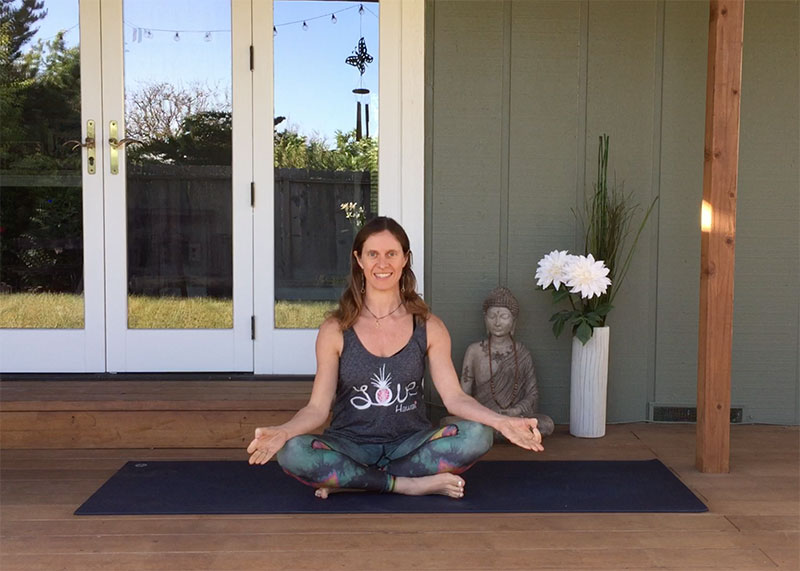
Tight hips, or any kind of pain in the hips, is a common chronic complaint these days for many people, and can often be the cause of low back pain, sciatic pain, knee or ankle pain, and even many running injuries. Living with chronically tight hips over many years may even eventually lead to the need to have hip replacement surgery. Obviously, we do not want to get to that stage if we can help prevent it earlier on.
If you have tight hips, it's likely that you also have some weakness in the hips. Our hips are part of our core and stablizing muscles, supporting our legs when we walk, run, and perform many other movements. However, it's extremely challenging to strengthen muscles that are tight. In fact, if we try to do so, they will likely just get tighter. So we first need to release the chronic tension through stretching, lengthening and releasing, before we then begin to strengthen.
Tight hips may be a result of sitting down too much, lack of movement, or too much movement and impact like running or other high impact sports, without stretching afterwards. Physical tension in the hips can often be stored emotions and stress because we hold a lot of emotional and even traumatic tension in our bodies, and that tension manifests as physical tension.
So when we practice hip opening stretches or yoga postures and breathe deeply to release the tension, we may find that some emotions arise as we release both physical and emotional tension. It's important not to resist these emotions. Allow them to be present, and then watch them move or even over time gently disappear altogether perhaps. Watch the emotions. Give them permission to be there. Do not resist or try to push them away. This technique of giving pain and emotions permission to be present has been so helpful in my own body and healing.
Our hips are also our source of grounding and connecting to the earth. Associated with the first energy center in our body, the Root Chakra, at the base of our spine, our foundation and stability in our body and in our life. So opening and releasing tension in our hips can also help us to feel more grounded in our lives and more connected to the earth and the world around us.
I'm happy to share with you 11 of my favorite yoga postures for releasing tight hips. These are great for all levels, including total beginners. I've provided some options and modifications for different bodies and abilities, so please listen to your body carefully and only move into the variation that feels available and comfortable for your body today, using your breath to guide you slowly and gently.
I recommend following along with this sequence as it is, and then progress to holding each pose for longer, up to twice the number of breaths noted below. Remember to always do both sides. Also, notice if there's a difference in sides as we often have one hip tighter than the other. Just notice, without judgement or attachment to any story or reason why this may be the case. Just notice and breathe a little more deeply or hold for an extra few slow deep breaths on the side that is tighter and where you feel more resistance.
Always listen to your body and remember to breathe deeply and slowly. If any pose doesn't feel good or you are experiencing any discomfort or pain, please release out of the pose gently and feel free to leave a comment or question in the comments section below and I will be sure to respond and provide some thoughts and additional modifications or options. Every body is different, and every day or moment is also different, so you may feel different each time you practice this sequence. Honor your body and accept where you are in your practice at any given time. This is the practice. I invite you to enjoy these stretches and poses and use this sequence as a time to journey inwards as well, bringing awareness to your breath and finding a meditative experience with every pose and every breath.
Knees To Chest
Lying on your back, bend your knees and draw your knees into your chest, with your hands on your shins, keeping your knees a little wider than hip width, and maybe even wider towards the armpits if that feels better for you. Keep your head and shoulders on the mat. Hold and breathe for 5 long slow deep breaths.
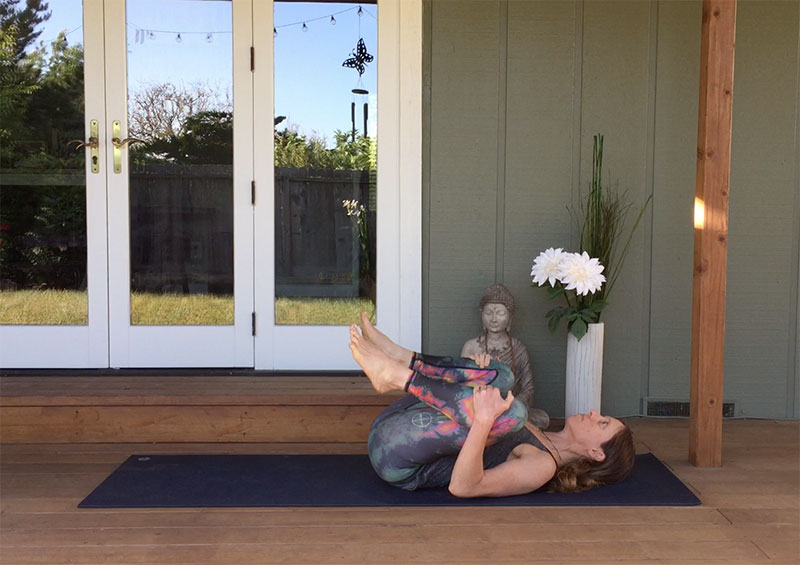
Happy Baby (Ananda Balasana)
Lying on your back, bend your knees and draw your knees into your chest, whilst keeping them a little wider than hip width, then extend your feet up so the soles of your feet are facing up towards the sky, then place your hands on the soles of your feet and press your feet and knees down towards the earth as you gently press your feet up towards the hands, providing some traction in the hip joints. Using your breath, you can gently rock side to side to release your hips more, then hold and breathe for 5 long slow deep breaths.
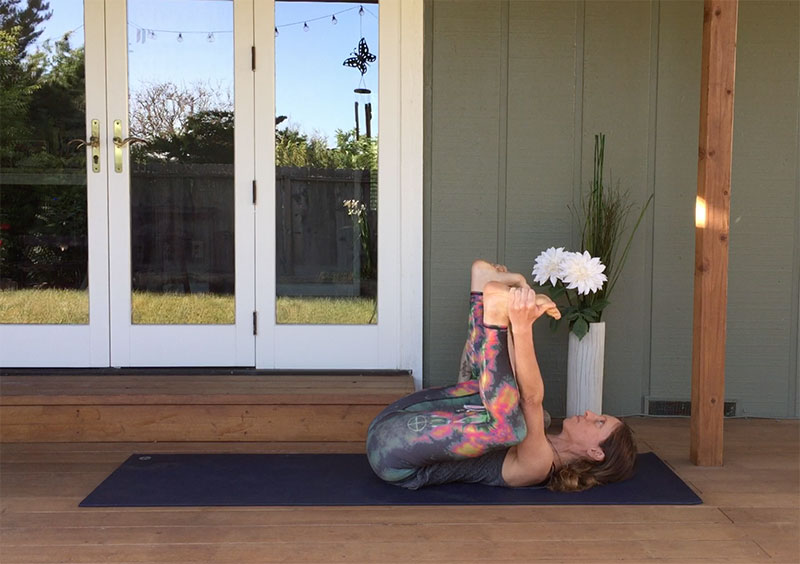
Eye Of The Needle (Sucirandhrasana)
Lying on your back, bend your knees and place your feet on the mat hip width apart. Take a deep inhale, then exhale and place your left ankle over your right thigh, keeping your left foot flexed to protect the knee. Take another deep inhale, then exhale as you place your hands under the back of your right thigh, lift your right foot off the mat and gently draw the right thigh towards your chest. Hold and breathe for 5 long slow deep breaths. For a deeper stretch you can place your left elbow on the left inner thigh and gently press it away from you. Repeat on the other side with the right ankle over the left thigh.
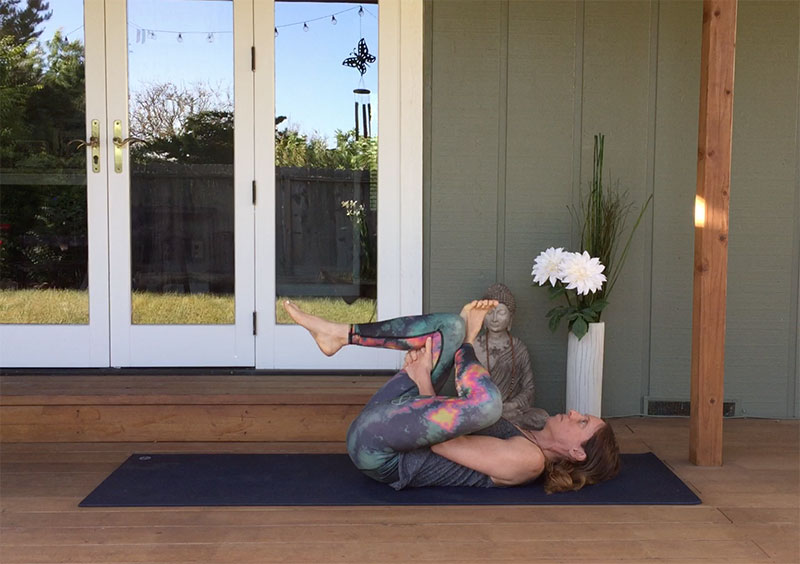
Child's Pose (Balasana)
Starting on hands and knees, all fours, place your knees wide to the sides of the mat, and place your big toes together, then sink your hips back into or towards your heels, and rest your forehead on the mat or a block or folded blanket. If your hips do not reach your heels, you can place a bolster or rolled up blanket between your hips and your heels for support. If you have bad knees, you can place a blanket under the knees for support. Your arms can be stretched out in front towards the front of the mat for Extended Child's Pose or you can place your arms back alongside your legs towards your feet for regular Child's Pose. The latter relaxes the shoulders a little more. Choose whichever option feels most available and comfortable for you and your body today and be fully present with your choice. Hold and breathe for 5 long slow deep breaths.
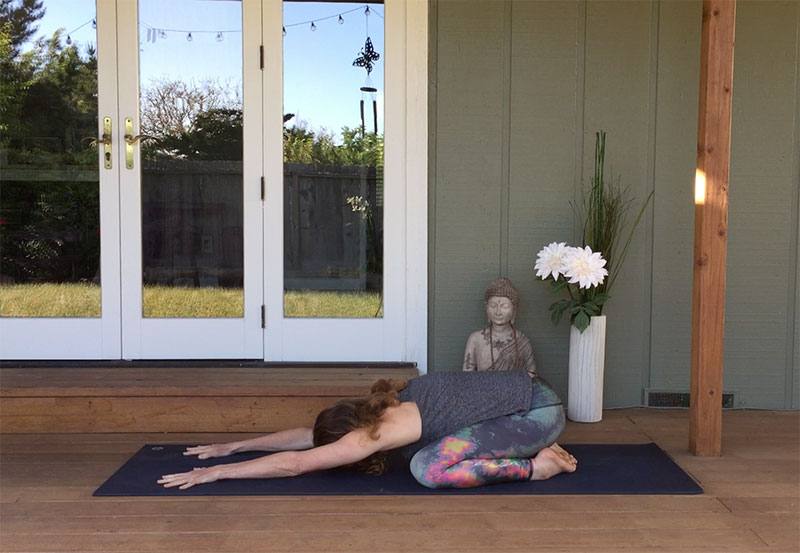
Lizard Pose (Utthan Pristhasana)
Starting on your hands and knees, all fours, lightly step your left foot forward and out towards the left side of your mat, with your foot pointing outwards about 45 degrees. Make sure your knee is over your ankle, not in front of your ankle or over your toes. It can be a little over to the left, but not over the toes. Either stay here with your hands on the mat supporting you and breathe, or if you'd like to go deeper, exhale as you shift your weight into your right hand and place the left hand on your left inner thigh and gently press your thigh away from you to the left. Again, you can either stay here and breathe, or if you'd like to go deeper still, exhale as you come down onto your forearms, or your forearms can be on blocks if that feels more available. Choose whichever option feels most available and comfortable for your body today and be fully present with your choice. Hold and breathe for 5 long slow deep breaths. Repeat on the other side with the right foot forward.
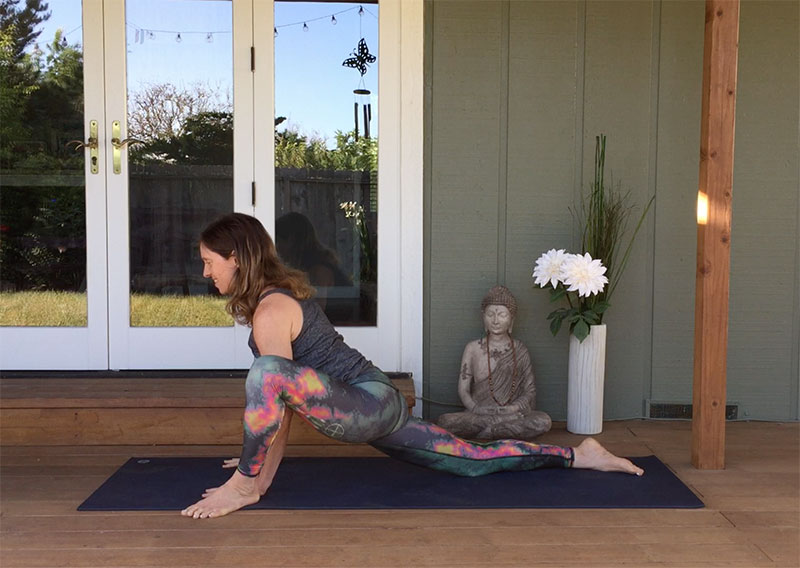
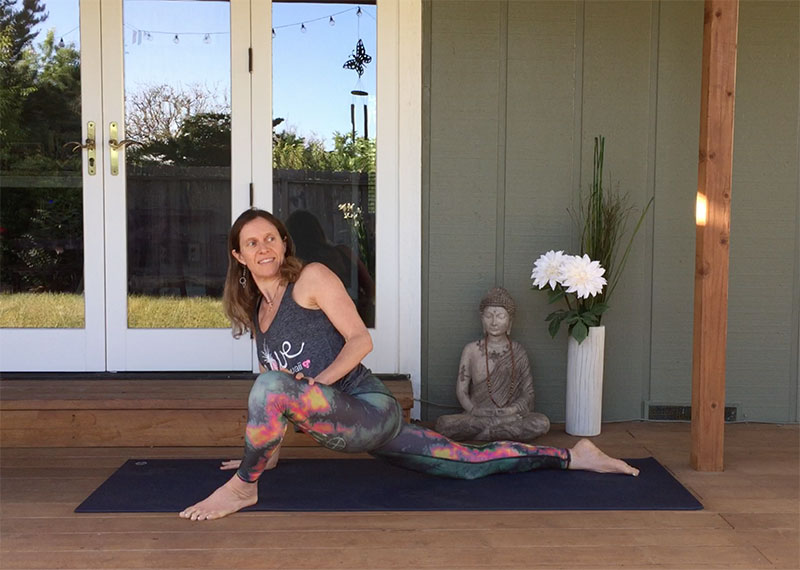
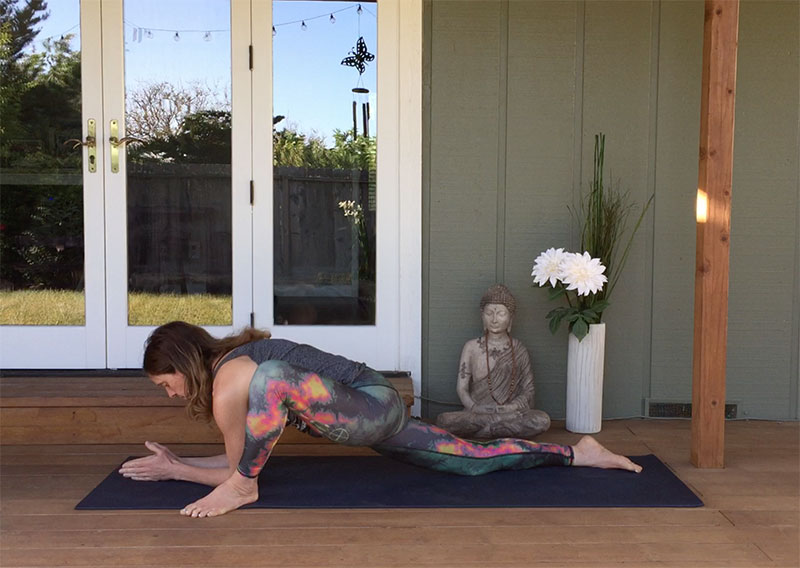
Pigeon Pose (Eka Pada Rajakapotasana variation)
Starting on your hands and knees, all fours, lightly place your left shin forward on the mat so your left foot is behind your right hand and your left knee behind your left hand, then extend your right leg out behind you with the top of the leg flat on the mat. You can place a block underneath your left hip if the hips are not level or if your left hip is not touching the mat. Inhale as you come onto the fingertips and lengthen the spine. If you'd like to go deeper, come onto the ball of the back foot and walk the back leg back a little, to open up the front hip more. Either stay here and breathe, or exhale as you fold forward over your left shin, keeping your spine long and resting your forehead down on the mat, or on a block or on folded arms. Keep length in your spine as you fold forward. Make sure you are not just rounding your back to get your head to the mat. If you are unable to fold all the way forward, you can place a bolster or folded blankets under the belly for support and fold over the bolster or blankets. Relax your shoulders. Hold and breathe for 5 long slow deep breaths. Repeat on the other side with the right shin forward.
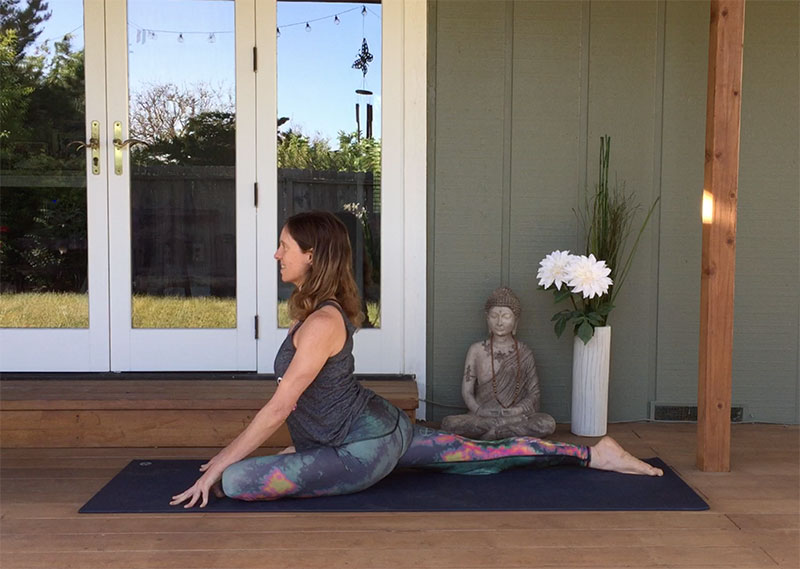
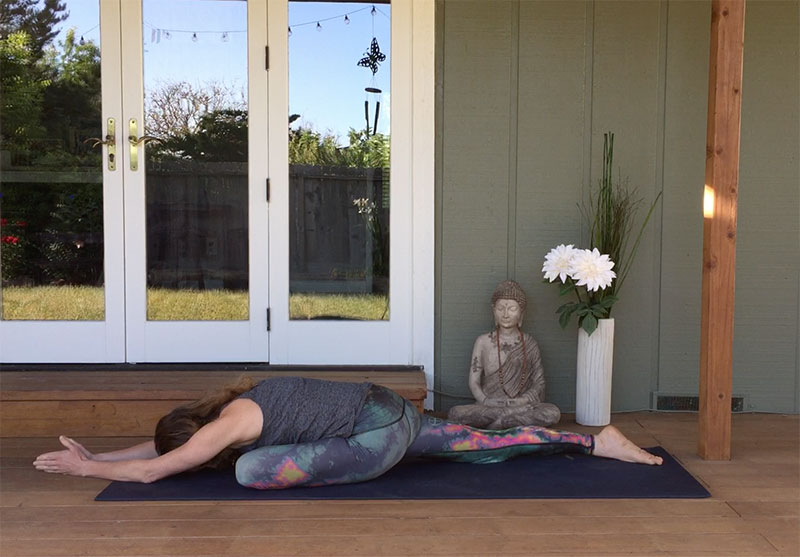
Butterfly (Baddha Konasana)
Start seated on your mat or on the edge of a folded blanket if your low back is slightly rounded, bend your knees and place the soles of your feet together, allowing your knees to draw gently out to the sides. Inhale as you lengthen the spine, and take a hold of your feet, and exhale as you fold forwards. Keep the spine long and tall. Hold and breathe for 5 long slow deep breaths.
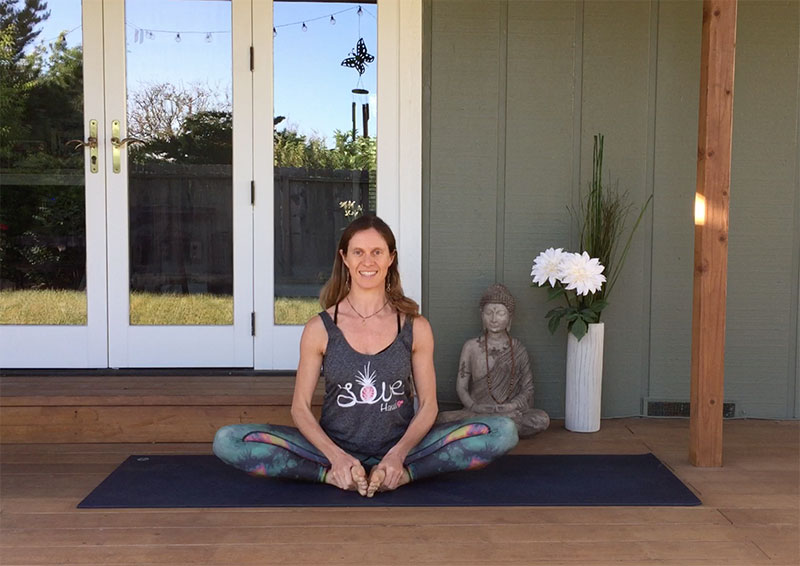
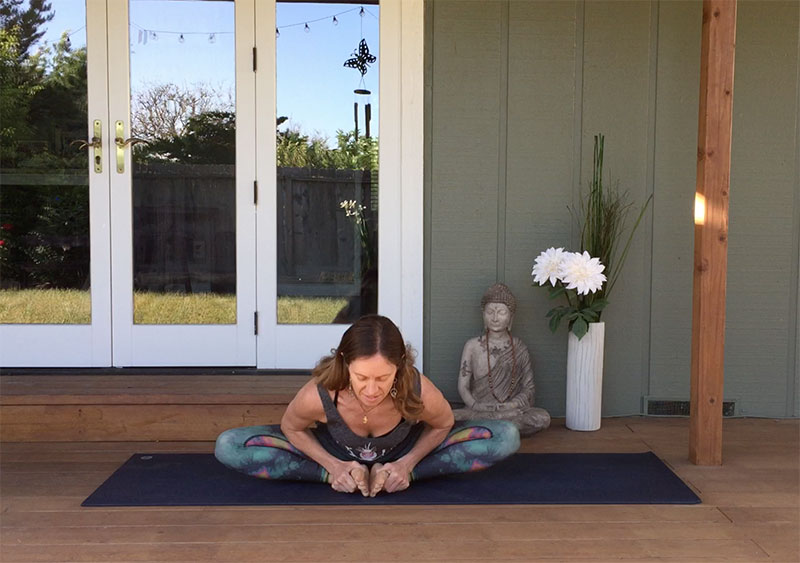
Cow Face Pose (Gomukhasana)
Start seated and cross your right knee over your left, so the knees are in line, then draw your feet to the sides and sit back onto the mat, or a blanket or block if your hips don't reach the mat. Keep your sitz bones rooting down and your spine long and tall. Either hold here and breathe, or if you'd like to go deeper, place your hands in front of your knees and gently fold forward keeping your spine long, and let your head and neck relax. Choose whichever option feels most available and comfortable for you and your body today and be fully present with your choice. Hold and breathe for 5 long slow deep breaths. Repeat with your left knee over your right.
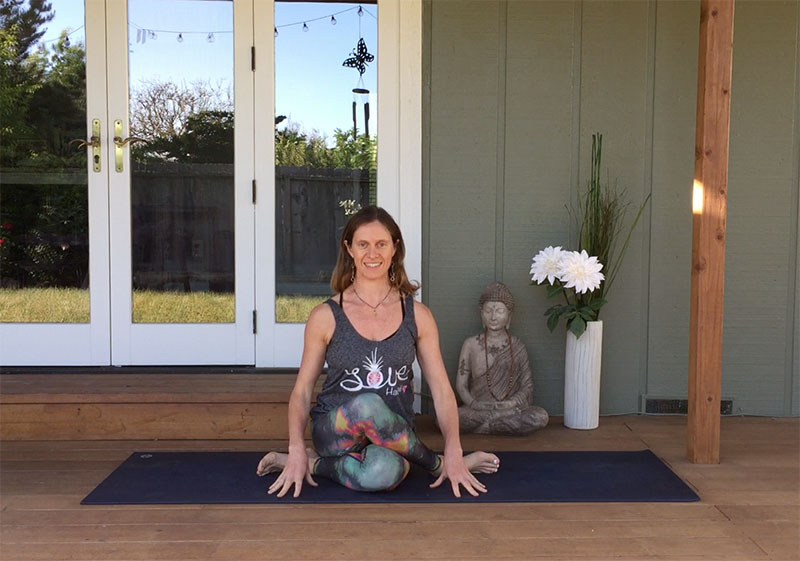
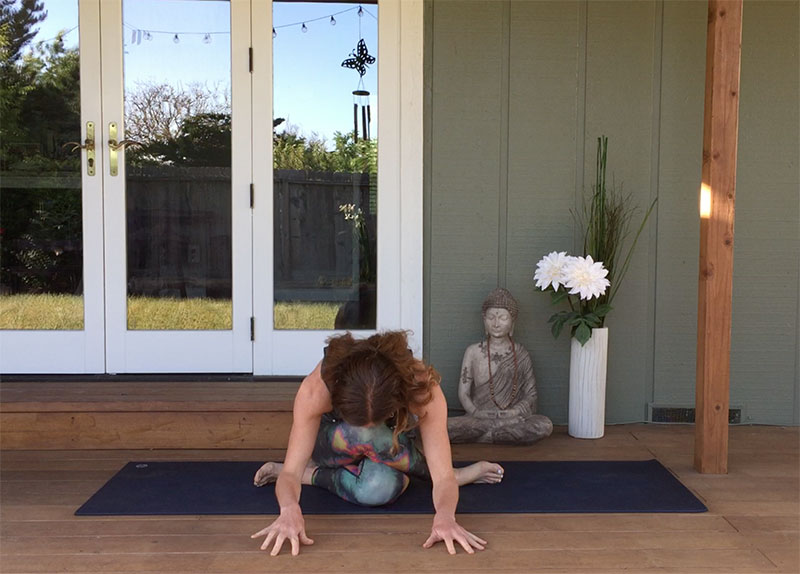
Squat Pose (Malasana)
Place your feet a little wider than hip width apart on the mat, with your feet pointing outwards, sink your hips down towards the mat, keeping the spine long and tall, reaching the crown of the head upwards, keeping your shoulders relaxed and your heart open, then bring your palms to your heart center. Your heels may or may not reach the mat. If they do not reach the mat, you can place a rolled up blanket under your heels for support. For a deeper stretch, you can gently press the elbows on the inner thighs and press outwards. Hold and breathe for 5 long slow deep breaths.
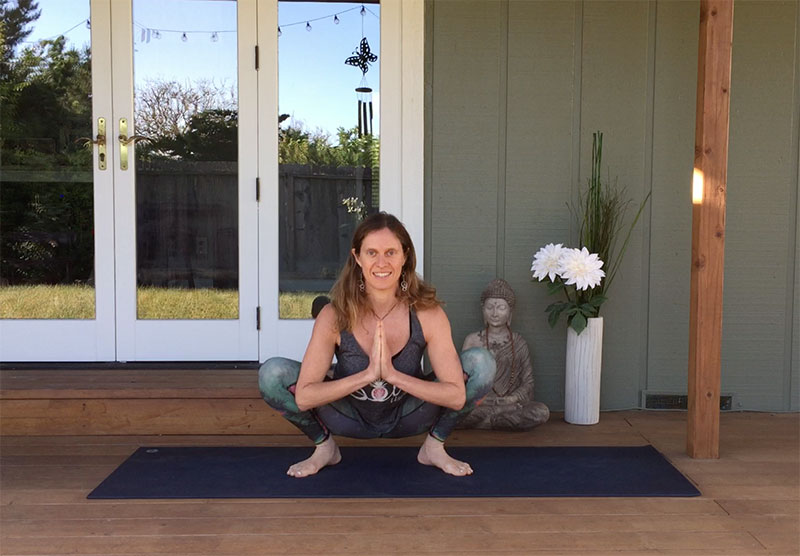
Seated Pose (Sukhasana)
Come into a comfortable seated crossed legged position. You can sit on the edge of a blanket if that feels more comfortable and available for you. Keep the sitz bones rooting down to the earth evenly and length the spine. Place the tip of the thumb and first finger together, hold and breathe for 5 long slow deep breaths. Repeat with the other leg in front.
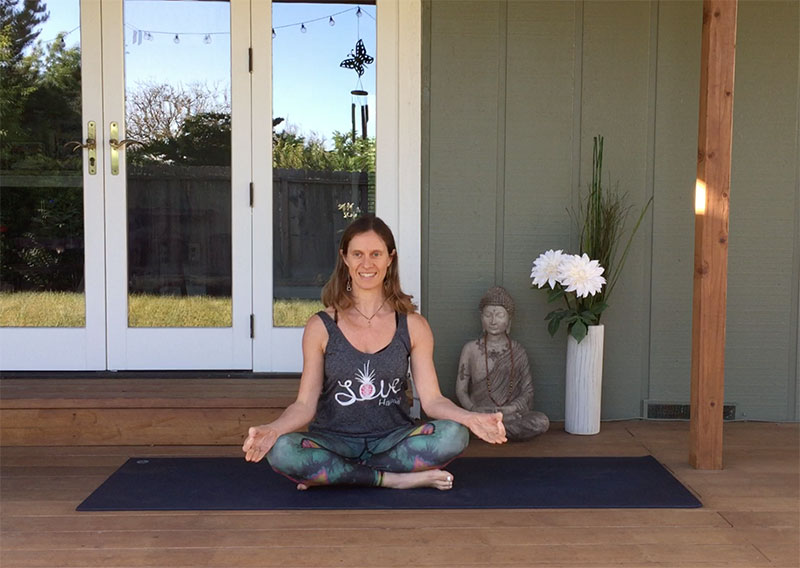
Lotus or Half Lotus (Padmasana)
From Sukhasana, place your left foot on the inside of your right inner thigh for Half Lotus. You can either stay here and breathe, or if you'd like to go deeper, place your right foot now on your left inner thigh. Use the breath to move slowly and gently. If you have any pain or discomfort in your knees, ankles or hips, move out of the pose and go back to Sukhasana, the previous pose, or any comfortable seated position where your spine can be nice and long. Be fully present with the choice you made for this last posture and be present with your body and your breath. Hold and breathe for 5 long slow deep breaths. Repeat with the right foot starting.
You may end your practice here by closing your eyes, and placing your thumb and first finger to touch into Gyan Mudra with the palms facing up and resting on your thighs. Gyan Mudra connects the fire and air elements, stimulating the brain and is associated with knowledge and wisdom, also symbolizing the unity of universal and individual consciousness, increasing focus and concentration, and cultivating a sense of calmness and openness during meditation. Draw your awareness inwards, and bring your internal focus to your breath. Spend as long as you like in this posture, meditating on your breath. If any thoughts come into your mind at any time, just give them permission to be there, then allow them to drift by as if they are clouds in the sky, drifting in and by, not identifying with the thoughts as being who you are, and gently come back to your breath, turning inwards. Enjoy this time for yourself. Namaste.
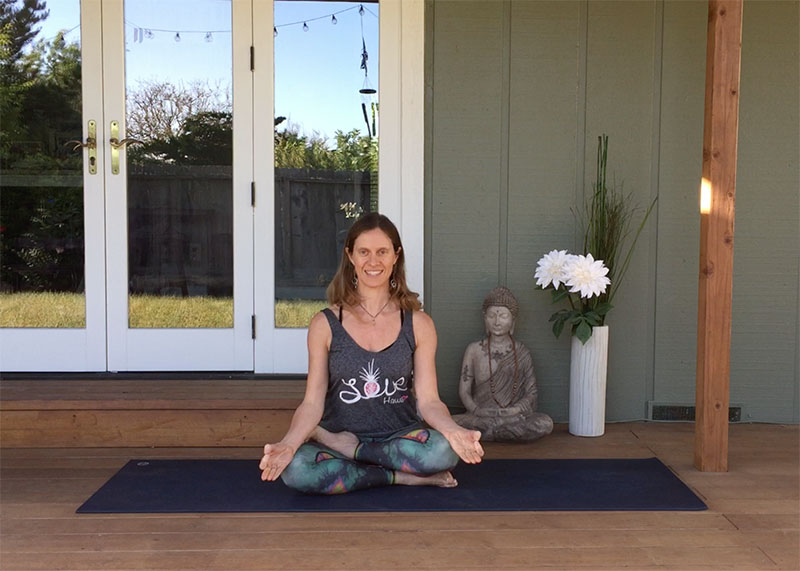
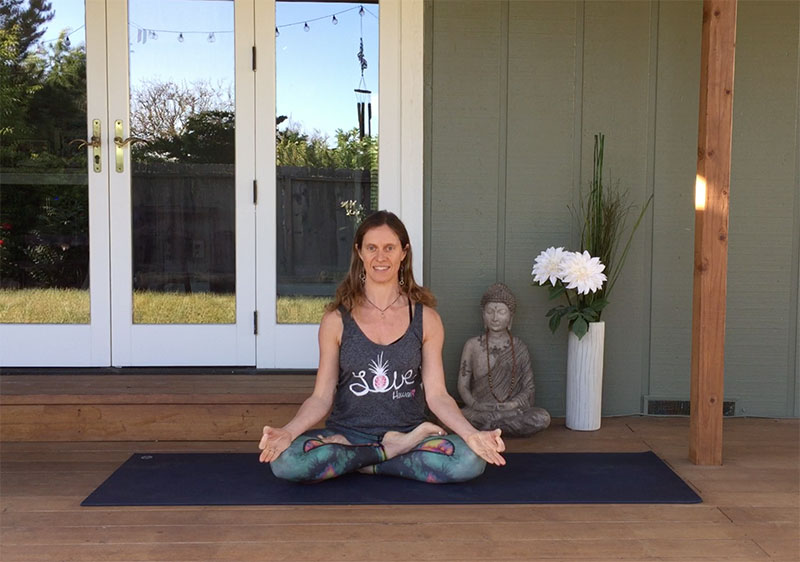
Feel free to follow along with our Online Yoga Class Videos for more postures that may help with tight hips.
If you have any questions or feedback on this article, please leave a comment in the comments section below. We'd love to hear from you!
Please also share this article with your friends and followers.
Author: Sally Mitchell, founder of Body Flows Yoga Retreats and RYT 200 Yoga Teacher leads yoga retreats in California, Colorado, Hawaii, Mexico and Costa Rica. Living in beautiful Sonoma, California, after 15 years in NYC and San Francisco, her approach as a leader and teacher is holistic, balanced and grounded. She enjoys practicing and studying Yoga and Buddhism, hiking and trail running in nature, traveling, writing and inspiring others to live a more spiritual and meaningful life.
The Body Flows website contains information intended to assist you in improving your health and overall well being, however, the information presented herein is offered for informational and educational purposes only and is not a substitute for the professional judgment of a medical professional.
Body Flows makes no warranty or representation whatsoever regarding the services or products provided through or in connection with the website. Please use your own discretion when performing any postures. Work at your own level and explore your own limits.
The reader and viewer of the information presented by this site assumes all risks when using the information provided herein. This site's operators, authors, owners, and affiliates disclaim any and all liability from the information provided herein. Any medical, financial, legal, health, psychological or other information provided on this site is not intended as a replacement for professional consultations with qualified practitioners. If this site provides health-related or medical information, no such information provided by this site is intended to treat or cure any disease or to offer any specific diagnosis to any individual as we do not give medical advice, nor do we provide medical or diagnostic services.
We recommend that you seek professional medical advice before performing any techniques, poses, postures or routines presented on our site. We thank you for visiting us and want the best for you, your practice and your health.